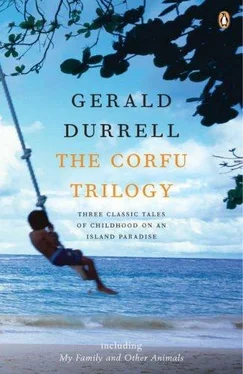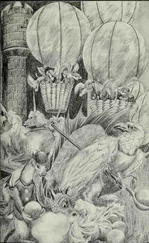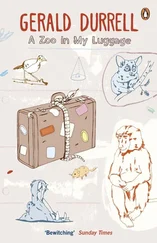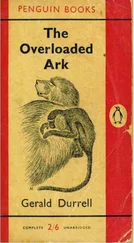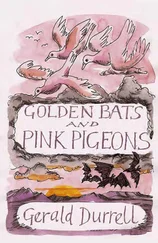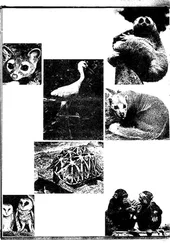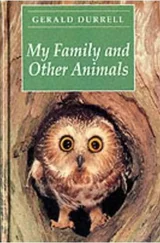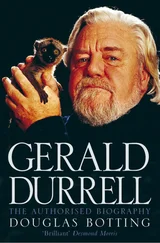Under the eaves of the villa itself the swallows had taken up residence. They had arrived a short time before we had, and their knobbly mud houses were only just completed, still dark brown and damp like rich plum-cake. As these were drying to a lighter biscuit brown, the parent birds were busy lining them, foraging round the garden for rootlets, lambs’ wool, or feathers. Two of the swallows’ nests were lower than the others, and it was on these that I concentrated my attention. Over a period of days I leaned a long ladder against the wall, midway between the two nests, and then slowly, day by day, I climbed higher and higher, until I could sit on the top rung and look into the nests, now some four feet away from me. The parent birds seemed in no way disturbed by my presence, and continued their stern work of preparing for a family, while I crouched on top of the ladder, and Roger lay at the bottom.
I grew to know these swallow families very well, and watched their daily work with considerable interest. What I took to be the two females were very similar in behaviour, earnest, rather preoccupied, over-anxious, and fussy. The two males, on the other hand, displayed totally different characters. One of them, during the work of lining the nest, brought excellent material, but he refused to treat it as a job of work. He would come swooping home, carrying a wisp of sheep’s wool in his mouth, and would waste several minutes skating low over the flowers in the garden, drawing figures of eight, or else weaving in and out of the columns that held up the grape-vine. His wife would cling to the nest and chitter at him exasperatedly, but he refused to take life seriously. The other female also had trouble with her mate, but it was trouble of a different sort. He was, if anything, over-enthusiastic. He seemed determined to leave no stone unturned in his efforts to provide his young with the finest nest-lining in the colony. But, unfortunately, he was no mathematician, and, try as he would, he could not remember the size of his nest. He would come flying back, twittering in an excited if somewhat muffled manner, carrying a chicken or turkey feather as big as himself, and with such a thick quill it was impossible to bend it. It would generally take his wife several minutes to convince him that, no matter how they struggled and juggled, the feather would not fit into the nest. Acutely disappointed, he would eventually drop the feather so that it whirlpooled down to join the ever-increasing pile on the ground beneath, and then fly off in search of something more suitable. In a little while he would be back, struggling under a load of sheep’s wool so matted and hard with earth and dung that he would have difficulty in getting up to the eaves, let alone into the nest.
When at last the nests were lined, the freckled eggs laid and hatched, the two husbands’ characters seemed to change. The one who had brought so much futile nest-lining now swooped and hawked about the hillsides in a carefree manner, and would come drifting back carelessly carrying a mouthful of insect life of just the right size and softness to appeal to his fuzzy, trembling brood. The other male now became terribly harassed and apparently a prey to the dreadful thought that his babies might starve. So he would wear himself to a shadow in the pursuit of food, and return carrying the most unsuitable items, such as large spiky beetles, all legs and wing-case, and immense, dry, and completely indigestible dragon-flies. He would cling to the edge of the nest and make valiant but vain attempts to get these gigantic offerings rammed down the ever-open gullets of his young. I dread to think what would have happened if he had succeeded in wedging one of these spiky captures down their throats. Luckily, however, he never succeeded, and eventually, looking more harassed than ever, he would drop the insect to the ground and fly off hurriedly in search of something else. I was very grateful to this swallow, for he provided me with three species of butterfly, six dragon-flies and two ant-lions which were new to my collection.
The females, once the young were hatched, behaved in much the same way as they had always done: they flew a little faster, there was an air of brisk efficiency about them, but that was all. It intrigued me to see for the first time the hygienic arrangements of a bird’s nest. I had often wondered, when hand-rearing a young bird, why it hoisted its bottom skywards with much waggling when it wanted to excrete. Now I discovered the reason. The excreta of the baby swallows was produced in globules which were coated with mucus that formed what was almost a gelatine packet round the dropping. The young would stand on their heads waggle their bottoms in a brief but enthusiastic rumba, and deposit their little offering on the rim of the nest. When the females arrived they would cram the food they had collected down the gaping throats, and then delicately pick up the dropping in their beaks and fly off to deposit it somewhere over the olive groves. It was an admirable arrangement, and I would watch the whole performance fascinated, from the bottom-waggle – which always made me giggle – to the final swoop of the parent over the tree-top, and the dropping of the little black-and-white bomb earthwards.
Owing to the male swallow’s habit of collecting strange and unsuitable insects for his young, I always used to examine the area below the nest twice a day, in the hope of finding new specimens to add to my collection. It was here that, one morning, I found the most extraordinary-looking beetle crawling about. I did not think that even that mentally defective swallow could have brought back such a large creature, or even that he could have caught it, but it was certainly there, underneath the colony. It was a large, clumsy, blue-black beetle, with a large round head, long jointed antennæ, and a bulbous body. The weird thing about it was its wing-cases; it looked as though it had sent them to the laundry and they had shrunk, for they were very small and appeared to have been constructed for a beetle half the size. I toyed with the idea that it may have found itself without a pair of clean wing-cases to put on that morning and had to borrow its younger brother’s pair, but I eventually decided that this idea, however enchanting, could not be described as scientific. I noticed, after I had picked it up, that my fingers smelled faintly acrid and oily, though it had not appeared to have exuded any liquid that I could see. I gave it to Roger to smell, to see if he agreed with me, and he sneezed violently and backed away, so I concluded that it must be the beetle and not my hand. I preserved it carefully, so that Theodore could identify it when he came.
Now that the warm days of spring had arrived, Theodore would come out to the villa every Thursday for tea, arriving in a horse-drawn cab from the town, his immaculate suit, stiff collar, and Homburg hat making a strange contrast to the nets, bags, and boxes full of test-tubes with which he was surrounded. Before tea we would examine any new specimens I had acquired and identify them. After tea we would wander about the grounds in search of creatures, or else make what Theodore would call an excursion to some neighbouring pond or ditch in search of new microscopic life for Theodore’s collection. He identified my strange beetle, with its ill-fitting electra, without much trouble, and proceeded to tell me some extraordinary things about it.
‘Ah-ha! Yes,’ he said, closely scrutinizing the beast, ‘it’s an oil-beetle… meloe proscaraboeus … Yes… they are certainly very curious-looking beetles. What d’you say? Ah, yes, the wing-cases… Well, you see they are flightless. There are several species of coleoptera that have lost the power of flight, for one reason or another. It is the life history of this beetle that is very curious. This, of course, is a female. The male is considerably smaller – I should say approximately half the size. It appears that the female lays a number of small yellow eggs in the soil. When these hatch out into larvæ they climb up any flowers nearby and wait inside the blooms. There is a certain type of solitary bee which they must wait for, and when it enters the flower, the larvæ… hitch-hike… er… get a good grip with their claws on the bee’s fur. If they are lucky, the bee is a female who is collecting honey to put in the cells with her egg. Then as soon as the bee has completed the filling of the cell and lays her egg, the larva jumps off onto the egg, and the bee closes the cell. Then the larva eats the egg and develops inside the cell. The thing that always strikes me as curious is that there is only one species of bee that the larvæ prey on. I should have thought that a great many of the larvæ catch hold of the wrong species of bee, and so eventually die . Then, of course, even if it’s the right kind of bee, there is no… um… guarantee that it’s a female about to lay eggs.’
Читать дальше
